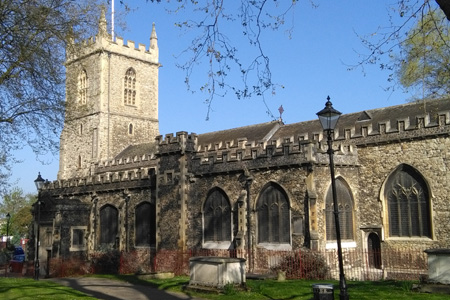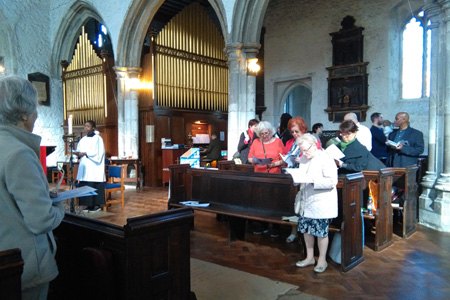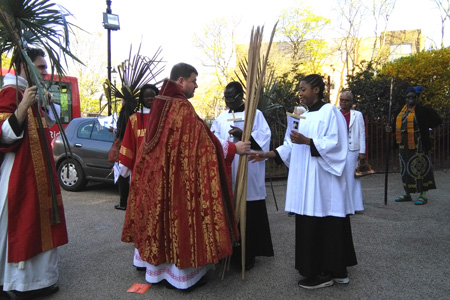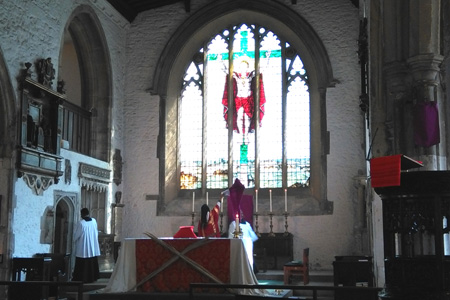| |
 |
 |
 |
| Comment on this report, or find other reports. |
 |
| Our Mystery Worshippers are volunteers who warm church pews for us around the world. If you'd like to become a Mystery Worshipper, start here. |
 |
| Find out how to reproduce this report in your church magazine or website. |
|
|
| 3145: St Dunstan and All Saints, Stepney, London |
 |
 |
 |
Mystery Worshipper: The Citric Ascetic.
The church: St Dunstan and All Saints, Stepney, London.
Denomination: Church of England, Diocese of London.
The building: Situated in a seven acre churchyard, the building is something of a focal point in the local area, standing out among the housing, not least for being a building considerably older than most of its surroundings. The current building is a mish-mash of the ages. Nothing remains of the 10th century wooden building and little remains of the 11th century stone church that replaced it; it is disputed as to whether or not the font dates back to the 11th century. Most of what is visible today goes back to the 15th century, though there have been various restorations in the intervening centuries, not least when the building was hit during the Second World War. One of the first things to strike you as you and approach and enter is the sheer size of the building. It has a very high ceiling, but this is supported by relatively narrow pillars, making the nave flow into the aisles. Behind the altar is a large stained glass window of Jesus on the cross, though most depictions of the cross had been covered up with a purple cloth. The pews had been rotated 90 degrees for Lent, so that they were oriented in a “college style” – instead of facing the front, the pews faced the opposite side of the nave. Much of the service was then conducted near the back of the church, with the chancel end of the building being used only for the eucharist.
The church: There has been a church presence in the area for over 1,000 years. It is perhaps most famous for its inclusion in the nursery rhyme "Oranges and Lemons," albeit the line "When will that be, say the bells of Stepney" is perhaps not the most memorable. Those particular bells could be heard pealing a good half hour before the service began. The church is part of the Inclusive Church movement and acts as a focal point for a wide variety of local community activities, including concerts, carers and toddlers mornings, a book club, and police ward panels. The church is currently organising a pilgrimage to the Holy Land in September 2017.
The neighbourhood: Stepney is a mostly residential area in the London borough of Tower Hamlets. The area has long been an attractive place for refugees and other migrants to settle, giving it a rich cultural and ethnic diversity. It was originally a village situated a few miles from London, with St Dunstan’s at its centre, but the growth of the city has subsumed the area. On the other side of the road from the church is a small city farm, home to a number of goats, donkeys and chickens.
The cast: The service was led by the rector, the Revd Trevor Critchlow, who wore a red and gold cope. He was assisted by Benjamin “Benjy” Tyler, parish assistant, as subdeacon in red tunicle, and another unnamed accomplice as deacon in red dalmatic. There were also several acolytes in black cassocks and white stoles.
The date & time: Palm Sunday, 9 April 2017, 10.00am.
What was the name of the service?
Sung Mass with Procession.
How full was the building?
I understand I was only one of quite a number of visitors on this particular Sunday. Not every pew was used, but those that were, were fairly full. I estimated there were around 60 people in total.

Did anyone welcome you personally?
Having arrived a little early, I sat in the church grounds for a while and spoke briefly with a couple who had come all the way from California to visit the church. We took mutual delight in the pealing of the bells. Upon entering the church, I was handed my hymn book, with the week’s booklet and a palm cross tucked inside. This was accompanied by a warm smile and a hearty “Hello.”
Was your pew comfortable?
No. The top of the back of the pew stuck out a bit and so dug into my shoulders. The seat was hard and unforgiving. I dread to think what a full 40 minute sermon might do to one’s back. The pews were also quite close together, so it made the possibility of kneeling quite tricky, though I did see one person try.
How would you describe the pre-service
atmosphere?
It was quite relaxed and informal. One person went round identifying all the newcomers (though she overlooked me), greeting them and letting them know what was going to happen in the service.
What were the exact opening words of the
service?
Coming over the PA system, a seemingly disembodied voice said, “Good morning all” before inviting us all to go outside so that we might embark upon the procession (more on this below).
What books did the congregation use during the
service?
We used the New English Hymnal, a slightly less-than-new looking green book. Inside this, we had a palm cross and the weekly notice sheet containing most of the liturgy and some of the songs to sing in the procession. Scriptural texts were taken from The Holy Bible, New Revised Standard Version. In order to make a change from normal, one of the scripture readings was shown as a video that dramatised a part of the passion narrative.
What musical instruments were played?
During the procession a single trumpet was played. For most of the main service we had an organ, though during the eucharist, the organist nipped down to the other end of the nave and played a piano. I was informed by one of the parishioners that the organ was moved here from another church in nearby Haggerston and had to have its pipes trimmed so that it would fit within St Dunstan’s, though it was still felt that the organ was rather oversized in relation to the rest of the church building.
Did anything distract you?
The children were kept in for the whole service, which inevitably meant there was a little noise from time to time. As it happened, this occurred during the intercessions, which made them slightly difficult to hear.
Was the worship stiff-upper-lip, happy clappy, or
what?
Let’s begin at the beginning, shall we? Having taken my pew and had a little look around, eavesdropping on a few conversations, we were quickly ushered out of the building and into the surrounding grounds of the church. Aided by a loudspeaker, the rector gave an outline of the procession, asking us to stay close together so that we could all hear the trumpeter. A few palm branches were handed out, including one to myself. Then the rector sprinkled some holy water about, though having been a few feet away and not felt a drop, I’m not sure how much water actually was sprinkled. A thurible was lit and off we went for a short walk around the neighbourhood. The incense wasn’t billowing out in great clouds, but was just enough to create that familiar dry clawing feeling at the back of the throat; not terribly conducive to singing. A bone of contention was the fact that we did not have a donkey. St Dunstan’s usually borrows one from the city farm across the road, but, for various reasons, none were available this year. The procession was a little over half a mile and took about 15 minutes to complete. When we came back, dropped off our palm branches and took our seats, the service resumed and felt rather more normal for a high church Anglicanism. There was a mixture of liturgy, prayers and hymns. The eucharist was ministered at an altar rail, though I noted that they used white wine instead of red. During the notices, thanks was given to the volunteers who had recently cleaned the church very thoroughly. The service ended up with the whole congregation gathering near the back of the church for a photo, which was taken from a gallery overlooking the nave.

Which part of the service was like being in
heaven?
I felt a great sense of camaraderie at St Dunstan’s. Visitors were not only made to feel welcome, but we were fully included and made to feel a part of the church.
And which part was like being in... er... the other place?
About two-thirds of the way through the procession, things started to go a little awry. First of all, the trumpeter, who had done a splendid job up until now, began to run out of puff, so the music faded a little. At the same time, we had moved on from the more familiar songs to one that not many seemed to know. Various people were getting lost in the lyrics, but did so just as the procession came round to the largest group of the public that we passed. So what should have been a triumphal and celebratory declaration of Hosanna to the King of kings ended up more as a slightly embarrassed humming along to the tune.
What happened when you hung around after the service looking lost?
I queued for and picked up a cup of coffee before slowly walking around the church, looking at various windows and the plaques on the walls. It was some time before anyone engaged me in conversation, but eventually I had a couple of pleasant chats with the church warden and a couple of parishioners, all of whom were very friendly.
How would you describe the after-service
coffee?
The coffee was branded as “Coffee with a conscience,” which hinted that it was most probably fair trade. It was a bit on the hot side and served in a very large paper cup, so it took some considerable time to drink. On some a table there was cake on offer, which slowly exerted its gravitational pull on the congregation as they drifted by.
How would you feel about making this church your regular (where 10 = ecstatic, 0 = terminal)?
7 – It’s a wonderful church to visit and I would highly recommend it to all. My personal taste for a regular church, however, is a little lower down the candle than this.
Did the service make you feel glad to be a
Christian?
Ye,s it did.

What one thing will you remember about all this in seven days' time?
Walking around a part of London I’d never been to before, holding a big branch and singing in public. It will stick in my memory for just how unusual an activity that is. |
|
|
 |
 |
 |
| We rely on voluntary donations to stay online. If you're a regular visitor to Ship of Fools, please consider supporting us. |
 |
 |
 |
| The Mystery Pilgrim |
 |
| One of our most seasoned reporters makes the Camino pilgrimage to Santiago de Compostela in Spain. Read here. |
 |
 |
 |
| London churches |
 |
| Read reports from 70 London churches, visited by a small army of Mystery Worshippers on one single Sunday. Read here. |
| |
|
|
|
|


